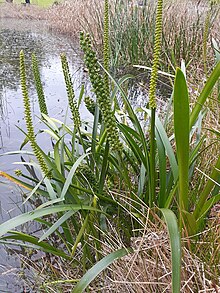| This article includes a list of general references, but it lacks sufficient corresponding inline citations. Please help to improve this article by introducing more precise citations. (April 2024) (Learn how and when to remove this message) |
| Cycnogeton procerum | |
|---|---|

| |
| Cycnogeton procerum on the edge of a pond. Image clearly shows the distinctive inflorescences. | |
| Scientific classification | |
| Kingdom: | Plantae |
| Clade: | Tracheophytes |
| Clade: | Angiosperms |
| Clade: | Monocots |
| Order: | Alismatales |
| Family: | Juncaginaceae |
| Genus: | Cycnogeton |
| Species: | C. procerum |
| Binomial name | |
| Cycnogeton procerum (R.Br.) Buchenau | |
Cycnogeton procerum (formerly Triglochin procera), is an aquatic plant species in the family Juncaginaceae. It is commonly referred to as 'water ribbons', but has many other names in Indigenous Australian languages, including Po-lan-go (Koorie name) and Gabirr (Marra name).

Description
Cycnogeton procerum is a distinctive aquatic herb, with light green, flat and strap-like leaves that often bend down to float in water. It has quite a variable growth habit, partly determined by environmental factors. It has 20–50 cm (8–20 in) erect slender green stems. The Inflorescence are a terminal raceme, dense, long spike that are about 30 cm (12 in) long. Flowers are terminal spikes at the end of the inflorescence, green or white. It can have few to many flowers while its fruit are 1-seeded indehiscent round capsules, 5–10 mm (0.2–0.4 in) long. It has a stout rhizome that supports its growth.
Phenology
Cycnogeton procerum flowers during warmer southern hemisphere months, primarily between September and February, with fruiting occurring between September and March. It is a monoecious species, and reproduces via seed and vegetatively.
Habitat and distribution
Cycnogeton procerum is found in fresh or brackish water, commonly in shallow lakes, ponds or slow-flowing streams. It is native to Australia, commonly occurring in all states, except rarely in Queensland. It is most widespread across South eastern Australia and Tasmania.
Aboriginal uses
Cycnogeton procerum and other similar species were an important food source for Aboriginal Australian people, notably in the coastal areas of Adelaide and surrounding regions. The tubers at the base of the stem were eaten roasted or raw. Some reports say that the tubers are sweet and have a pea-like flavour.
European cultivation
Cycnogeton procerum has been cultivated for its ornamental qualities, especially in aquatic garden settings and water features. It grows well in a variety or garden settings and is commercially available in Australian plant and indigenous nurseries. Ideal growing conditions are in slow-flowing water to 2 m (7 ft) deep with full sun or semi-shaded areas.
Threats and conservation
Currently there is no conservation threat for Cycnogeton procerum in Australia.
References
- ^ "Atlas of Living Australia". Cycnogeton procerum. Retrieved 2 April 2024.
- Murray, Louisa. "Genus Cycnogeton". New South Wales Flora Online. PlantNET. Retrieved 3 April 2024.
- "Water Ribbons". Grasslands. Biodiversity of South-Eastern Australia.
- Aston, Helen. "Cycnogeton procerum". Flora of Australia. Retrieved 2 April 2024.
- ^ Clarke, A (1988). "Aboriginal Use of Subterranean Plant Parts in Southern South Australia". Rec. S. Aust. Mus. 22 (1): 73–86. Retrieved 3 April 2024.
- Yarra Ranges Council. "Yarra Ranges Local Plant Directory". Cycnogeton procerum. Yarra Ranges Council. Retrieved 2 April 2024.
| Taxon identifiers | |
|---|---|
| Cycnogeton procerum |
|
| Triglochin procera | |